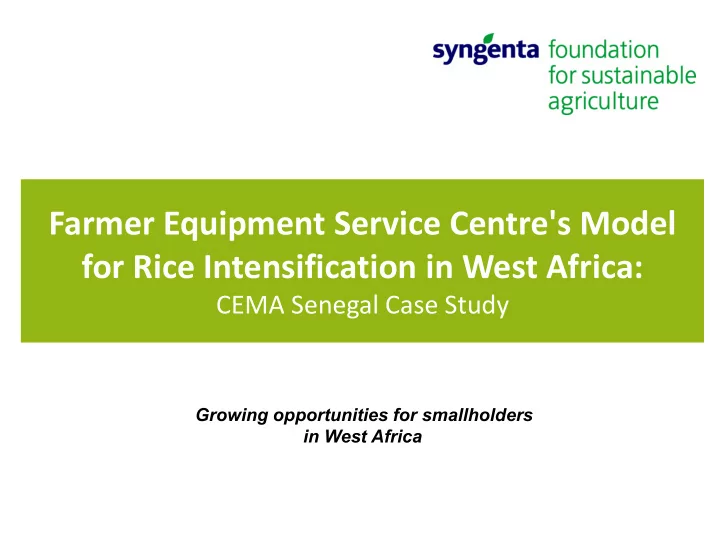

Farmer Equipment Service Centre's Model for Rice Intensification in West Africa: CEMA Senegal Case Study Growing opportunities for smallholders in West Africa
Agenda 1. Supporting Rice Producers in WA 2. Why Mechanization 3. Objective of a CEMA 4. The CEMA Pilot 5. Results and Outlook 6. Learnings and Outlook 7. Development Opportunities 2
Supporting Rice Producers in WA Context • SFSA supports West African rice growers since 2009 • Focus on 5 countries (Côte d’Ivoire, Ghana, Burkina Faso, Mali, Senegal) • Most activities in partnership with other organizations 1. Capacity building, agronomic advice and training SFSA’s offer 2. Data-management and compromises extension 3 modules 3. Agricultural service models for mechanization and input use 3
Why mechanization Historically, mechanization programs in West Africa have been ● implemented with poor results. Reasons for this include: 1. Lack of capital available for investments 2. Lack of supply chains and maintenance infrastructure for equipment 3. Lack of know-how in the provision of mechanized services 4. Lack of enabling policies for the sustainable development of business models However, mechanization can greatly increase productivity as it ● facilitates timely harvest and opens opportunities for double cropping. 4
Objective of a CEMA A Farmers Equipment Service Center (CEMA) provides soil ● preparation, harvesting and storage services in irrigated areas The services are fee-based and run commercially through income ● generated by these fees Service Centres are envisaged to be owned by farmer cooperatives ● In Senegal, Service Centres enable doubling the rice cropping cycle ● through more rapid harvesting and soil preparation The execution of timely harvest also improves crop quality and ● quantity 5
CEMA UPG UPG started its activities in 1999 in the Basin of Pont Gendarme, ● Lower Senegal River Valley. It covers an area of 245 hectares. UPG is made up of 8 Economist Interest Groups and is formally ● constituted with management bodies. The main activity of UPG members is small scale farming. The ● number of producers involved is about 320. Yields are “good” (5 -7 T/ha), however, yield increases are limited by ● poor field preparation and water management, weed pressure, bird feeding and untimely harvesting. Better access to soil preparation services, harvesting, and storage capacities is required. Conceptually, the structure of a CEMA consists of a manager and ● several employees to enhance availability, accessibility and transparency of services for small producers. 6
CEMA UPG 7
CEMA UPG: Service Provision A Farmers Services Centre is offering the following services: Soil preparation: off-set; ploughing; leveling, ridging ● Harvesting and threshing ● Storage: paddy storage, seed storage ● Others services: driving trainings (drivers), mechanical trainings, ● fertilizer advise with RiceAdvice (ICT tool) Harvesting Storage Soil preparation 8
9
Results and Outlook: Technical Parameters Technical Parameters CEMA UPG (Senegal) Tractor Combine Harvester Power (KW) 100 176 Working width (m) 2.3 3.5 Daily capacity (ha) 10 3 Hourly capacity (ha) 1 0.25 Work period (months) 6 4 Working time (hours/year) 1 200 640 Consumption (L/ha) 15 40 10
Results and Outlook: Financial Parameters Financial Parameters CEMA UPG (Senegal) Tractor Combine Harvester 39 70* Upfront costs (million CFA) 25 000 135 000 Service delivery cost (FCFA/ha) Annual revenue (million CFA) 30 28 Annual charges (million CFA) 18 11 Gross margin (million CFA) 12 17 # Farmers served (2015) 219 Total product turnover (kg) 675 300 *partially subsidized 11
Outlook and Results: Revenue Generation 160,000 140,000 120,000 100,000 80,000 60,000 40,000 20,000 - 2015 2016 2017 Revenue Provision Harvester Revenue Offset Provision Revenue Storehouse 12
Learnings and Outlook I/III Need for conducive agricultural policies. Senegal has put in ● place subsidy schemes for agricultural equipment. This helps to improve the profitability and reduce upfront investment requirements. Guarantee funds can help farmer communities access loans ● and increase loan volumes. The guarantee fund negotiated by SFSA with banks allows increasing debt capacity in equipment of beneficiaries by 3.5. Cost of service delivery repayment. Service charges are ● calculated to reach a return on investment within 3 years 13
Learnings and Outlook II/III Management of Farmer’s Service Centres . An agreement is ● signed between producers and the CEMA Manager who entrusts the management of equipment to the CEMA and is also responsible for the technical and financial management The establishment of financial and administrative operating ● procedure manuals facilitate streamlining the management and allow for a more rapid replication of the model. 14
Learnings and Outlook III/III Further efficiency gains can be achieved. Preliminary ● observations carried out suggest that progress can be achieved with a efficient allocation of staff time and resources, improved quality of plot topography (levelling), better training of machine drivers and down time of machinery. Plots with low-yield (2-3 tonnes) display a reduced profitability when harvested with the combine. In such cases manual mowing or Rice Ripper should be advised. Development of technical and economic references on the use ● of equipment in farming areas. Data available at the level of research are too old or simply do not exist. It should be considered as a priority to work with local research stations (ISRA and AfricaRice in Senegal and the IER of Kogoni in Mali) to agree on technical parameters of equipment (follow up sheets). 15
Development Opportunities Setting up new services, tested by SFSA and AfricaRice (Levelling, ● Direct Paddy Seeder, RiceAdvice) Replication of the CEMA model with partners (AGRA/USAID, CIDA, ● SAED, JICA, CARI) Advocacy for the adoption of the CEMA model in national and ● regional policy development Outsourcing of activities to a private company to facilitate the ● management of farmer equipment Catalysing a market for equipment and maintenance provision by ● showcasing the financial viability of mechanization service models 16
Thank you! SFSA aims to create value for smallholder farmers in developing countries through innovation in sustainable agriculture and the activation of value chains. The foundation supports smallholders to become more professional growers. 17
Recommend
More recommend